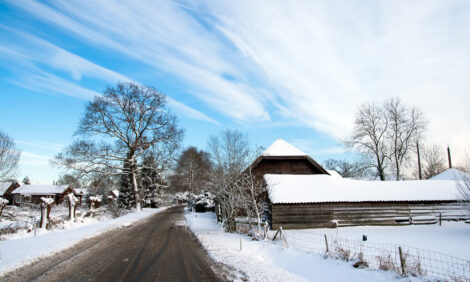



Feeding Drought-Damaged Peanut and Cotton to Beef Cattle
Standing cotton should be fed to dry beef cows and lactating cows should opt for the unharvested peanuts, says the latest advice about feeding damaged crops to cattle.Farmer feeders or beef men with access to arable produce can feed damaged cotton and peanut crops to supplement beef cattle.
Abandoned crops can reduce feed costs and extend grazing, allowing pasture regeneration, according to staff at the University of Georgia.
But, nutritional quality must be matched to the animal's requirements, meaning that a lactating cow can make use of baled peanut vines while stockers graze, or are preconditioned, on unharvested peanut vines.
Abandoned Peanuts
Grazing unharvested peanuts or harvesting the crop for hay can provide nutritional value similar to alfalfa hay, say Jacob Segers and Curt Lacy of Georgia Extension.
Cattlemen who are weaning calves may consider grazing unharvested peanut vines. As a rule, peanut vine yields are about 1.5 times the actual peanut yield For instance, an estimated peanut yield of 500 pounds would provide about 750 pounds of vines per acre.
"When grazing peanut vines, an ideal supplement would be soybean hulls," advises Mr Segers, Beef cattle specialist. "Soybean hulls are often cost-effective and can be included based upon performance needs of the animals grazing the peanut vines."
For mature dry cows, 1 per cent of body weight per day is likely all that would be required," adds Mr Segers.
"It is important to remember that feeding pelleted soybean hulls at more than 30 per cent of the total diet increases the risk of bloat. Therefore, caution should be exercised if supplementing peanut vines with pelleted soybean hulls to animals with high nutrient requirements (e.g., lactating cows or growing steers)."
Mr Segers adds that stocking rate should not exceed 500 pounds of calf per acre. At a stocking rate of one 500-pound steer per acre receiving 1 per cent body weight of soybean hulls per day, ADG of 2.5 pounds per day is possible for about 30 days (about 75 pounds per calf).
"Peanut vines can be harvested for hay and fed to lactating cows or growing animals. Since the vines should be very similar to alfalfa hay, the value of the hay should be about $200 per ton. Cut peanut vines for hay with a mower-conditioner.
"At $3.50 per gallon for diesel, cash costs to mow-condition and bale will be around $35 per acre," says Mr Seger.
Using the vine estimate above of 750 pounds of vine per acre, this amounts to $90 per ton cost to put up hay, he adds.
However, with a value of $200 per ton, this is still an economical decision.
Curt Lacy tells cattlemen they should closely consider economics and compare the economics of adding weight and value to calves by grazing versus $35 per acre for hay cost plus transportation from the field and storage.
In some instances, the peanuts may be dug and the peanut and vine baled together. Peanuts are very high in energy due to the high fat content (48 per cent ), and peanuts are also high in protein (28 per cent ), he explains.
"If the peanuts yield 500 pounds per acre, the resulting peanut plus vine hay would be about 15 to 18 per cent crude protein and 65 to 68 per cent TDN," says Mr Lacy. "Either dry or lactating cows can use this hay. Dry cows require about 8 per cent protein and 52 to 55 per cent TDN."
"Lactating cows require approximately 60 per cent TDN and 11.5 per cent protein," says Mr Lacy.
He explains: "Because of the high levels of fat in the peanuts, the hay must be limited to avoid depressed fiber digestion and potential scouring. If the peanuts yield 500 pounds per acre, then limit intake to 1 per cent of body weight per day."
In addition, lactating cows need about 1.5 per cent of body weight per day of grass hay and 1 per cent of body weight for a dry pregnant cow.
Another serious concern, Mr Lacy says, is with baling peanuts and vine following a period of drought stress is the presence of aflatoxin and other mycotoxins that can at minimum have negative reproductive effects in cattle, and in larger doses drastically increase death loss.
Because of this, he recommends avoiding feeding drought-stressed peanut hay to lactating dairy cattle if the nuts have not been removed.
"In beef cattle, the hay can be used, but should be mixed with grass hay so as not to exceed 1 per cent of body weight per day," says Mr Lacy.
"Supplemental hay should be at least 10 per cent crude protein and 58 per cent TDN."
He advises farmers to contact local Cooperative Extension agent for help with the analysis. The only way to know if cows are receiving adequate amounts of protein and energy is to have the hay analyzed for nutrient content, he concludes.
Abandoned Cotton
Research conducted at the Southwest Georgia Experiment Station in Plains, Ga., indicates that 1 acre of standing cotton can provide sufficient grazing for one mature dry cow for 35 to 40 days. Therefore, a 40-acre field of abandoned cotton could provide about one to one and a half months of grazing for 40 dry beef cows. Refer to Georgia Cooperative Extension Bulletin 1311, Using Cotton Byproducts in Beef Cattle Diets, for more information on feeding cotton crop residues to beef cattle.


